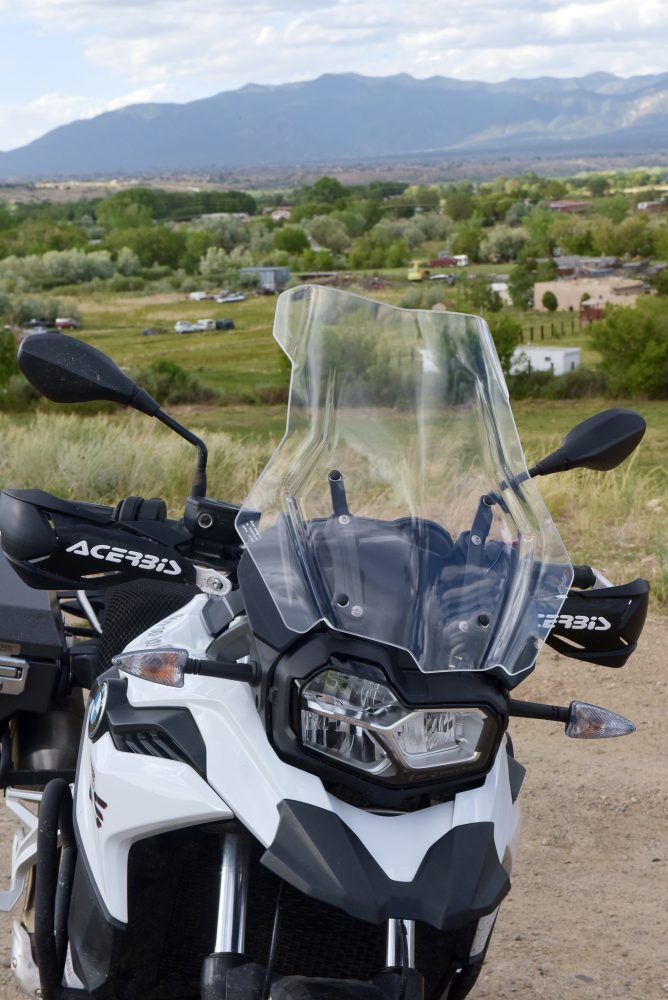Clearly I had underestimated the importance of choosing the right-sized windscreen for my 2020 BMW F 750 GS. With fellow adventure riders Parker Mims of Carlsbad, New Mexico, and Patrick Reid Hobby of Greenville, South Carolina, I tore off across the lower Texas landscape from the border town of Ruidoso.
The spring winds had been daunting in previous weeks, and anyone who rides with me knows I detest strong winds, hence my handle “Wind Chime,” handed to me last year by Africa Twin riders Ed Goldner and Sundaram Raman of San Antonio. I mean, I really hate wind, “So why don’t you have the right windscreen?” asks Hobby during a break, texting me a Touratech link. It was true. I had installed a Puig Touring Windshield about a year earlier, which was about 5 inches shorter than I actually needed for long-distance riding. A short while later, the three of us were sandblasted by large swaths of dirt being blown across the barren landscape. The dirt devils seemed to take turns knocking into us. Mims pulled his bike off the pavement, riding fiercely in the dirt alongside the road as if nothing were happening. Ahead of me, Hobby zigzagged his bike, playing in the strong breezes. I gripped my handle bars and took a few deep breaths, then ordered a new screen as soon as we reached our destination.
I was thrilled when Touratech’s large Adventure Touring Windscreen arrived, and then disappointed when it didn’t fit. I promptly called the company and inquired. The windscreen had cost $230. “You have to order a bracket for it,” explained a Touratech rep. Listed on the bottom of Page 2 of the Touratech page, the bracket would have to be ordered independently at a cost of more than $200. I reluctantly forked over the $20 return fee and then turned to Puig. After paying $129 for a Puig Touring Plus Windshield and waiting a few more days, I was able to install the windscreen in a couple of minutes.

I could say the 5-inch difference in the height of the screen was a help, but that wouldn’t be quite accurate. It was a huge help. After installation, I took my bike to where the wind blows free, the Taos Mesa. Heading into a direct easterly wind, I noticed I had forgotten to lower the visor on my helmet. The ride was quieter, and the bike seemed more stable, although it was my head, and not the bike, that had been feeling the brunt of wind gusts. For months I had been riding with a sore neck and shoulders and not quite understanding why.


While not much can be done with side winds, I immediately noticed a new ease in riding. It took only a few minutes for my brain to assimilate to the new height level.
The Puig brothers got their start as Industrial Plástico Puig in the 1960s in a 328-square-foot garage in Granollers, Spain. They began by manufacturing complete fairings in polyester fiber for Derbi and Vespa, then branched into windscreens. Today, the company manufactures their windscreens with 3- or 4-millimeter high-impact acrylic so that wind blast is raised above the rider. The thickness resists vibration, scratching, and cracking. The touring model I ordered, at 21 inches, was wind-tunnel tested and created for long-distance riding, a fact I am grateful for, along with a few good friends.
Puig’s windscreen offerings come in a wide variety of heights, from sporty racing screens to larger touring screens with visors and extensions to self-adjusting screens that fit any ride with a push of a button. Puig’s Electronic Regulation System offers riders an immediate increase of nearly 2 inches or a decrease of an inch with the installed handlebar regulator. The screens are smooth with rounded edges and are offered in clear, smoke, dark smoke, black, blue, and carbon.
$129 | puigusa.com/en
Our No Compromise Clause: We carefully screen all contributors to ensure they are independent and impartial. We never have and never will accept advertorial, and we do not allow advertising to influence our product or destination reviews.
Read more: Necessity Fuels Innovative Creations at 2022 Overland Expo West


